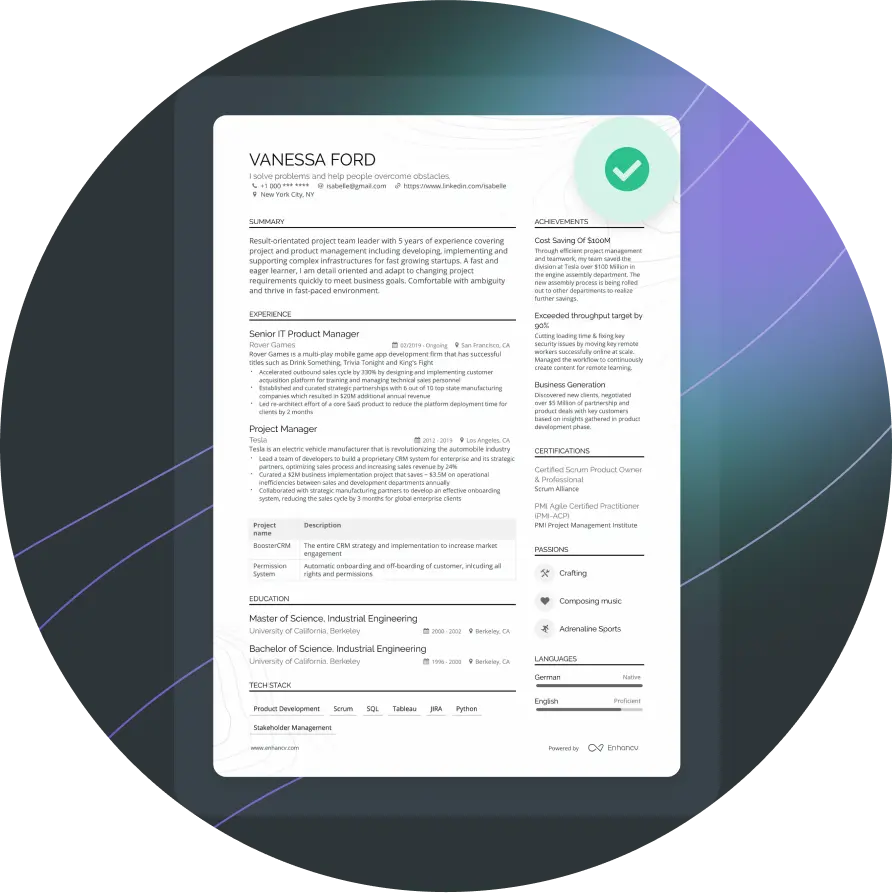
A resume critique tool that makes sure your resume stands out for all the right reasons
Resume Critique is a free and quick tool that generates a personalized checklist that helps you fix your resume
ATS compatibility checklist
Visual appeal checklist
Consistency and error checklist
Content variety checklist
Impactful wording checklist

Extra functionalities to boost your resume and pass the ATS
Content Analyzer
With the content analyzer, you’ll not only correct spelling errors but also get practical tips on how to improve your content. If you’ve missed adding quantifiable achievements, the content analyzer will underline the problematic section. Its algorithm is based on studying thousands of resumes, ensuring you're showcased in the best possible way.
Referral Link
Sharing your resume with someone who can offer a fresh perspective is a step towards landing that job. Use the referral link to your resume and send it to someone who’s been employed at the same company, or even better, in the same department or position. Connect with ex-employees on LinkedIn or join relevant Facebook Groups. Their opinion on your resume can provide valuable insights and feedback.
What checklists do professional resume writers use to provide a resume critique?
Professional resume writers use a detailed set of criteria to assess and critique resumes. While there may be variations based on individual experience and expertise, here's a general checklist they use:
- Contact Information: Are the name, phone number, email, and location (optional) correct, current, and prominently displayed?
- Formatting: Is the resume easy to read, with consistent fonts and font sizes? Is it neatly arranged with a clear hierarchy and good use of whitespace? Is it free of grammatical errors and typos?
- Length: Is the resume concise, ideally fitting onto one or two pages? Does it avoid unnecessary information?
- Objective/Summary: Is there a clear and concise objective or summary that effectively communicates the candidate's career goals and qualifications?
- Experience: Are the roles listed in reverse chronological order? Are job titles, companies, and dates of employment clear and accurate? Do the descriptions focus on achievements and impact rather than just job duties? Do they use action verbs and quantify achievements where possible?
- Skills: Are key skills highlighted, and do they match with the job description? Are there any generic or outdated skills that should be removed?
- Education: Is the education section clear and accurate, with the name of the institutions, the degree(s) obtained, and the dates of attendance?
- Customization: Has the resume been tailored to the specific job description, highlighting relevant experience and skills?
- Keywords: Does the resume use keywords from the job description, which could help it pass through Applicant Tracking Systems (ATS)?
- Professional Development: Are relevant certifications, trainings, or continued education listed?
- References: Rather than listing references, does it state "References available upon request," if at all?
- Avoiding Red Flags: Does the resume avoid controversial information, such as political affiliations or religious beliefs? Does it exclude personal information, such as age, marital status, or social security number?
- Accomplishments: Is there a clear focus on achievements and results in each role, instead of just responsibilities?
- Cover Letter: If applicable, does the cover letter complement the resume, with a tailored message that conveys enthusiasm and fits the company culture?
- Consistency: Is there consistency in terms of language, tense, formatting, and style?
A resume is not just a list of past jobs and education. It's a marketing document designed to sell the candidate's skills, experience, and potential to prospective employers. The best resumes are carefully crafted with this purpose in mind.



